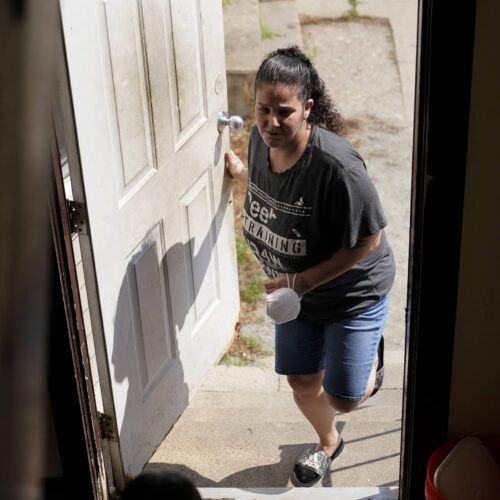Introduction
Subscribe on Google | Apple Podcasts | Spotify | Amazon
MILLSVILLE, West Virginia — About 70 miles northwest of the nation’s capital, past wineries in the affluent Virginia countryside and across the state line into West Virginia, there’s a house on a hill in a deteriorating neighborhood.
Inside sits Melody Shaffer, rubbing her red-rimmed eyes at the dining table. Her boyfriend Chris Pascoe paces between the dimly lit kitchen and living room. Paint peels from a nearby door frame.
“I have no clue,” Shaffer repeatedly says when asked where they would go now that they were about to be evicted.
It was the day before Thanksgiving. At the bustling Walmart down the road, shoppers filled their carts with potatoes, stuffing, green beans and pumpkin pie, oblivious to the scene that had unfolded that morning in the county courthouse.
Jefferson County Magistrate Judge Vicki D’Angelo had ruled in favor of three landlords and ordered the tenants living in their homes — including Shaffer and Pascoe — to vacate by Dec. 3.
“To wait and do this in the wintertime, right before it gets cold …” Shaffer trailed off.
Statistically speaking, not much is known about evictions that are occurring outside the nation’s urban areas during the COVID-19 pandemic. There is no national system that monitors eviction cases in real time. The largest set of publicly available data is gathered by Princeton’s Eviction Lab, which is tracking cases in six states and 31 cities.
Data in those urban areas show mixed trends. In places with few tenant protections, the number of cases is going up, according to the Eviction Lab.
But tenants’ lawyers in the country’s less populated regions say they’re also handling more cases now that the federal moratorium on evictions has expired.
States like West Virginia, South Dakota, Delaware and Arkansas have been slow to dole out rental assistance from the federal government — money that’s meant to be a levy holding back a flood of evictions.
Nationwide, only about 34% of the $45 billion Congress sent to states and cities for rental assistance had been distributed by Oct. 31, according to data from the U.S. Department of the Treasury.
Other pots of money have been slow to be spent too, including $9 billion the Department of Housing and Urban Development sent to states and cities to combat housing-related COVID-19 fallout.
“My frustration is widespread,” said Brent Thompson, executive director for East River Legal Services, which provides representation to low-income residents in eastern South Dakota. “It’s just sad when you see a continuing problem day in and day out, and there’s [only] so much you can do for them.”
Access to information and aid in eviction cases
Thompson said the biggest hurdle he’s faced in South Dakota is lack of information for tenants, many of whom were living in poverty before COVID-19 swept through the state.
“We’ve developed a culture where people don’t tend to avail themselves of protections afforded to them,” Thompson said. “This isn’t a new problem. It’s a problem that’s being magnified by the pandemic and reaching a crisis point because of the pandemic.”
Back when the federal eviction moratorium was in place, people living in South Dakota tended to simply move elsewhere when their landlords threatened to evict, rather than fight for their right to stay, Thompson said.
And many tenants either don’t know about the state’s $200 million rental assistance allocation from the federal government or haven’t been able to access those funds.
As of Oct. 31, only 4% of that money had been distributed to tenants and landlords, according to data from the U.S. Department of the Treasury. A November report from the National Low Income Housing Coalition placed South Dakota and Wyoming last among states for the share of rental assistance they’d sent to tenants and landlords.
The South Dakota Housing Development Authority, which is administering the state’s rental assistance programs, has distributed aid to more than 5,200 households with money from the federal government, said Amanda Weisgram, spokesperson for the agency. The state approved 75% of the completed applications it received.
Weisgram noted the need for assistance isn’t as acute in South Dakota because the state’s businesses weren’t forced to close during the pandemic, and residents weren’t required to stay home.
But Thompson’s office saw a 30% jump in eviction cases for four months in a row earlier this year, and he said the need for attorneys is growing. Only eight attorneys cover this 33-county region, which spans 30,000 square miles. His territory is home to a large population of undocumented migrant workers and Indigenous people, groups that have historically been exploited by landlords.
South Dakota ranks last in terms of access to legal representation, according to the National Center for Access to Justice.
‘We don’t know if they’ll drink’
In Delaware, landlords have been hesitant to sign up for rental assistance programs, said Dan Atkins, executive director of Community Legal Aid Society Inc.
Landlords have balked at providing financial records to the state government, and they haven’t wanted to give up their right to evict tenants in exchange for receiving rental payments.
“You can drag a horse to water, but you can’t make them drink,” Atkins said. “We’ll drag them to the water, but we don’t know if they’ll drink.”
Many of the lowest-income tenants in Delaware don’t know about the rental assistance available to them. They don’t have reliable access to the internet and some people aren’t able to read, Atkins said. All of this is a challenge when the state requires pages of documentation proving financial hardship.
Plus, there’s a narrative in the low-income community that no one is going to help, he said.
Over 80% of landlords are represented in eviction cases in Delaware, Atkins said, while fewer than 5% of tenants have lawyers by their side. There’s not enough legal aid to go around.
“We are starting to see the floodgates open a bit, and we are looking over our shoulder and wondering if it’s going to be a big tidal wave soon,” Atkins said.
As of Oct. 31, only 10% of Delaware’s $200 million allocation in rental assistance had been doled out to tenants and landlords, according to data from the Treasury Department.
In Arkansas, state officials were lagging behind most other states for the first seven months of the emergency rental assistance program, but they picked up the pace of distributing money in October, Treasury Department data show. Still, that’s only used up 22% of the state’s $174 million allocation.
“We are starting to see the floodgates open a bit, and we are looking over our shoulder and wondering if it’s going to be a big tidal wave soon.”
Dan Atkins, executive director of Community Legal Aid Society Inc.
“The public badly needs access to rental assistance funds,” said Kendall Lewellen, housing subject area manager for the Center for Arkansas Legal Services, adding that the state amended its policies to make it easier for tenants to access the aid. “I just hope that it isn’t too late for most people.”
As of Oct. 15, Lewellen’s office had handled twice as many landlord-tenant cases in 2021 as it did in the same time period in 2020.
Eviction in Arkansas is uniquely punitive, Lewellen said. It’s the only state in the nation that charges tenants with a crime for failing to pay their rent and vacate their home.
Nearly 450 people were charged with that misdemeanor crime between March 2020 and November 2021 in Arkansas, according to data from the state’s court system. Of those, 133 were found guilty.
“Most places in Arkansas have stopped enforcing the law, but some places are still issuing arrest warrants for tenants who fall behind on their rent,” Lewellen said. “In more rural areas, the practice still happens.”
Country roads
Back in West Virginia, Shaffer and Pascoe were living in a neighborhood littered with rotting tires and stacks of lumber. The house next door was shrouded by dead vines.
As of Dec. 15, they hadn’t found a place they could afford to rent, and they were thinking they’d have to spend the night outside. They didn’t apply for rental assistance because the process would take weeks to complete, and Pascoe’s income as a handyman in the flooring business had dried up.
So had the income of Johnny Herrell, who was in the tree-trimming business in nearby Charles Town. Harrell said his employer died, and he was suddenly out of work. He said he had never missed a rental payment before, but he could no longer afford to pay $500 a month.
His landlord, Alex Salgado, purchased the small building Herrell was living in about 18 months ago. Herrell was the first person he had to evict.
“It’s a circle, right?” Salgado said. “I need to get money in so I can pay for the building.”
Like Shaffer and Pascoe, Herrell found out the day before Thanksgiving that he would be evicted by Dec. 3. He didn’t want to move into his son’s home, which was already crowded. The only place he could think to live was inside an old pop-up camper on a nearby campground. It isn’t insulated. And the temperatures were already dropping below freezing at night.
At the last minute, Herrell’s relatives helped him rent an apartment in Maryland, so he wouldn’t have to sleep in the camper.
“It felt lousy,” Herrell said of his experience in the courtroom. “You work all your life, and you’re fine, and you bust your butt, and you keep going no matter what happens, and you know what? It was heartbreaking.”
Help support this work
Public Integrity doesn’t have paywalls and doesn’t accept advertising so that our investigative reporting can have the widest possible impact on addressing inequality in the U.S. Our work is possible thanks to support from people like you. Donate now.
Read more in Housing
Housing in Crisis
HUD got $9 billion to combat COVID-19 impacts. Only a quarter has been spent.
Cities and states that received the funds say they’ve been overwhelmed and focused on spending other federal money with tighter deadlines.




Join the conversation
Show Comments